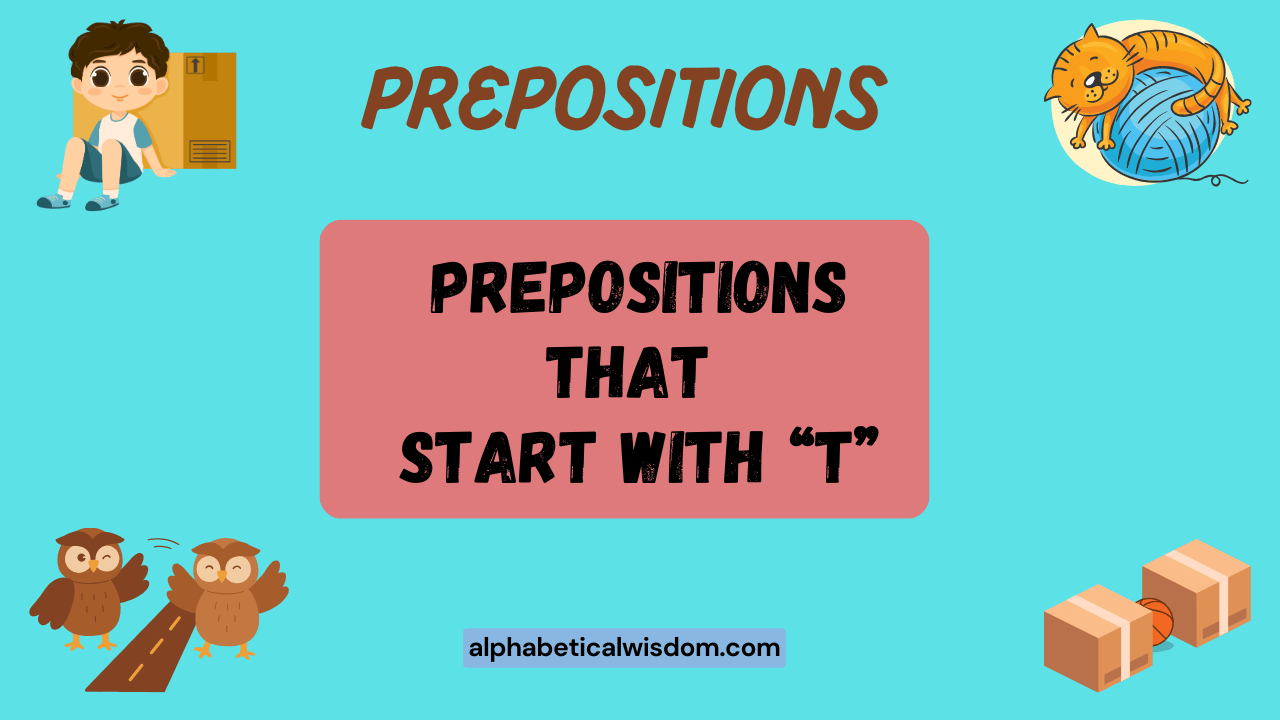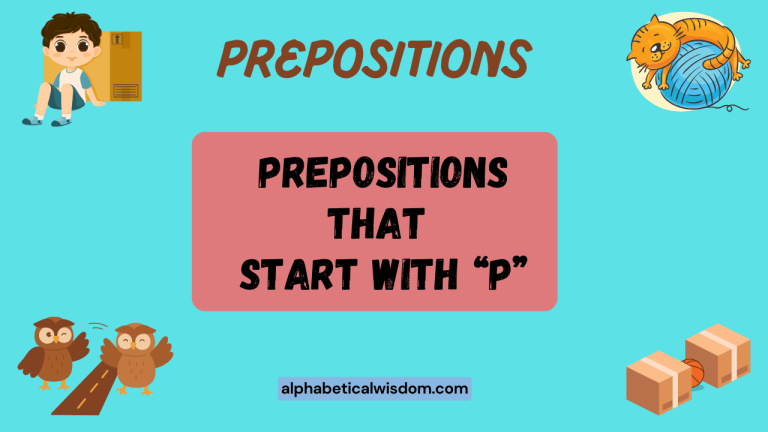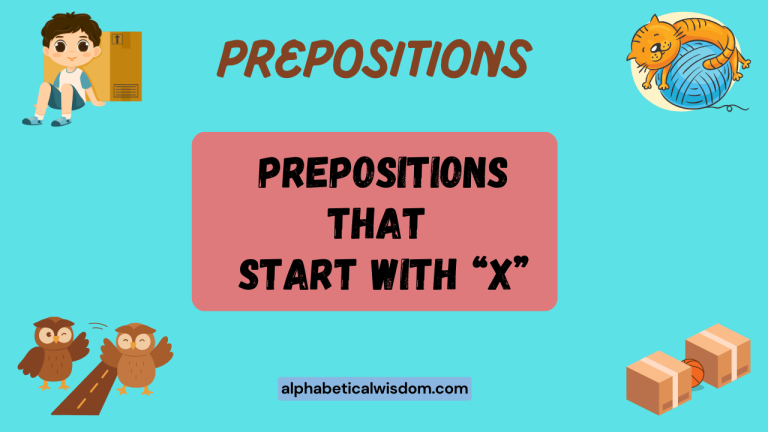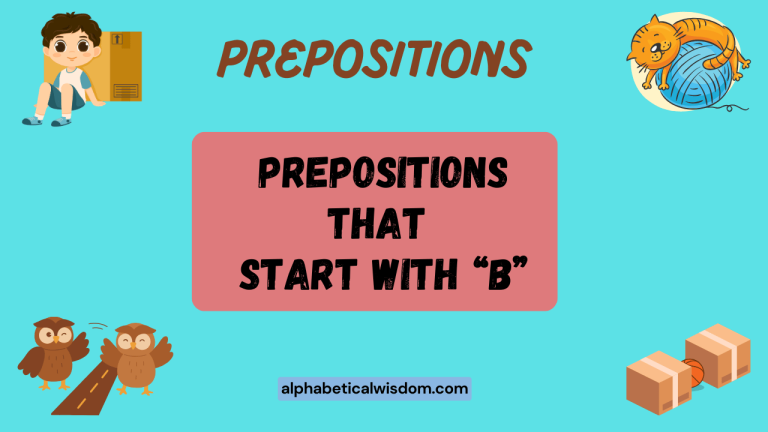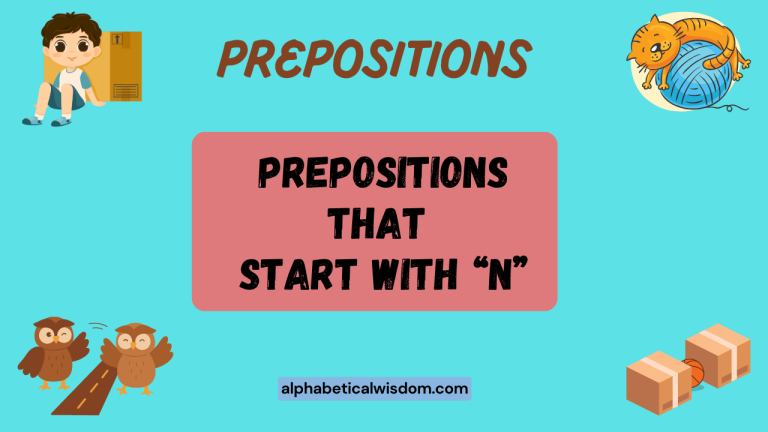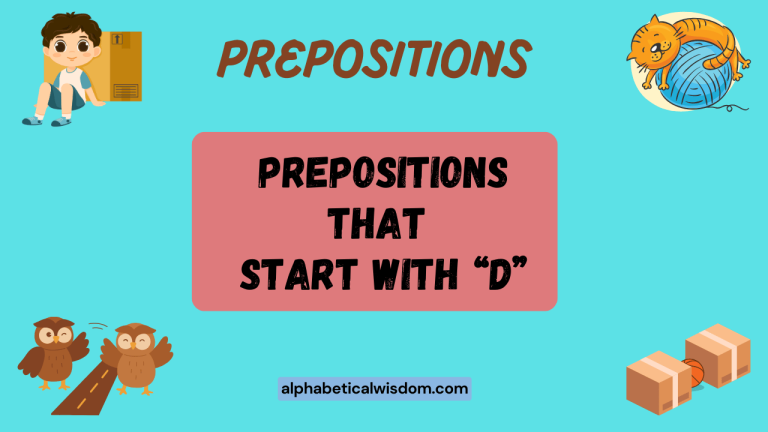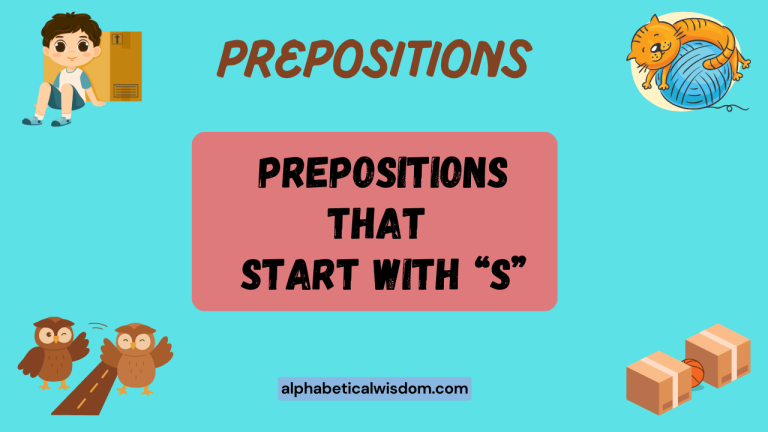Mastering Prepositions That Start With ‘T’ in English Grammar
Prepositions are essential components of the English language, acting as bridges that connect nouns, pronouns, and phrases to other parts of a sentence. Understanding prepositions, especially those starting with the letter ‘T,’ is crucial for constructing clear, accurate, and grammatically sound sentences.
This article provides a comprehensive guide to prepositions that begin with ‘T,’ exploring their definitions, usage, common mistakes, and practical exercises to enhance your proficiency. Whether you’re an English language learner, a student, or simply someone looking to refine their grammar skills, this guide will equip you with the knowledge and practice needed to master these important words.
This article is tailored for English language learners of all levels, from beginners seeking a foundational understanding to advanced speakers aiming to polish their grammar. Native English speakers can also benefit from this comprehensive review, addressing potential blind spots in their preposition usage and reinforcing best practices.
By the end of this guide, readers will be able to confidently identify, interpret, and utilize prepositions starting with ‘T’ in various contexts, improving their overall communication skills.
Table of Contents
- Introduction
- Definition of Prepositions
- Structural Breakdown of Prepositional Phrases
- Types and Categories of Prepositions
- Examples of Prepositions Starting With ‘T’
- Usage Rules for Prepositions Starting With ‘T’
- Common Mistakes with Prepositions Starting With ‘T’
- Practice Exercises
- Advanced Topics in Preposition Usage
- Frequently Asked Questions (FAQ)
- Conclusion
Definition of Prepositions
A preposition is a word that connects a noun, pronoun, or noun phrase to other words in a sentence. It typically indicates the temporal, spatial, or logical relationship of the object to the rest of the sentence.
Prepositions are essential for providing context and clarity, allowing us to understand where, when, how, or why something is happening.
Prepositions are classified as a closed word class, meaning that new prepositions are rarely added to the English language. They are primarily function words, serving to connect grammatical elements rather than carrying substantial meaning on their own.
However, their specific meaning is determined by the context in which they are used. For instance, the preposition “to” can indicate direction, purpose, or relationship, depending on the sentence.
The function of prepositions extends beyond simply indicating location or time. They also play a crucial role in expressing abstract relationships, such as cause and effect, possession, and manner.
Understanding the multifaceted nature of prepositions is key to mastering their usage and avoiding common grammatical errors. The following sections will delve deeper into the structural components and various categories of prepositions, providing a solid foundation for advanced understanding.
Structural Breakdown of Prepositional Phrases
A prepositional phrase consists of a preposition and its object, which is typically a noun or pronoun. The entire phrase functions as an adjective or adverb, modifying other elements in the sentence.
Understanding the structure of prepositional phrases is essential for correct sentence construction and interpretation.
The basic structure of a prepositional phrase is: Preposition + (Optional Modifiers) + Object. The object of the preposition is the noun or pronoun that the preposition relates to the rest of the sentence. Modifiers, such as adjectives or adverbs, can be added to the object to provide additional details. For example, in the phrase “to the old house,” “to” is the preposition, “the” and “old” are modifiers, and “house” is the object.
Prepositional phrases can be categorized based on their function within a sentence. Adjectival phrases modify nouns or pronouns, while adverbial phrases modify verbs, adjectives, or adverbs.
The position of the prepositional phrase in the sentence often indicates its function. For instance, a phrase placed after a noun typically functions as an adjective, while a phrase placed at the beginning or end of a sentence often functions as an adverb.
Recognizing these structural patterns can greatly improve your ability to analyze and construct grammatically correct sentences.
Types and Categories of Prepositions
Prepositions can be categorized based on their meaning and function. While many prepositions can fit into multiple categories depending on context, understanding these distinctions can help clarify their usage.
Simple Prepositions
These are single-word prepositions, such as to, at, in, on, for, and with. They are the most common type of preposition and are used to express basic relationships of time, place, and direction.
Compound Prepositions
These prepositions consist of two or more words, often including a simple preposition. Examples include according to, because of, in front of, and in spite of. Compound prepositions function as a single unit and provide more specific information than simple prepositions.
Participle Prepositions
These are words that originate as verb participles but function as prepositions. Common examples include considering, regarding, during, and including. These prepositions often introduce information related to the action or state of the verb from which they are derived.
Prepositions of Time
These prepositions indicate when something happens or its duration. Examples include at, on, in, before, after, during, until, and since. They help to establish a temporal context for the events described in a sentence.
Prepositions of Place
These prepositions indicate the location or position of something. Examples include at, on, in, above, below, beside, near, and between. They provide spatial context and help to visualize the relationships between objects and their surroundings.
Prepositions of Direction
These prepositions indicate movement or direction. Examples include to, from, into, onto, through, and toward. They describe the path or trajectory of an object or person.
Examples of Prepositions Starting With ‘T’
This section provides extensive examples of prepositions that start with the letter ‘T,’ categorized by their specific usage. Each example is designed to illustrate the preposition’s function and meaning within a sentence.
Understanding these examples will help you to use these prepositions correctly and confidently.
Examples of “To”
The preposition “to” has multiple meanings, including direction, purpose, and relationship. It is one of the most versatile prepositions in the English language.
| Example | Usage |
|---|---|
| I am going to the store. | Direction |
| She went to learn French. | Purpose |
| This gift is to you. | Relationship |
| The key to success is hard work. | Relationship |
| They listened to the music. | Direction |
| He is related to her. | Relationship |
| She contributed to the charity. | Direction |
| I prefer coffee to tea. | Preference |
| He is addicted to gaming. | Relationship |
| She is committed to her job. | Relationship |
| The answer to the question is simple. | Relationship |
| We traveled to Italy last summer. | Direction |
| He spoke to the audience with confidence. | Communication |
| She raised her glass to toast the happy couple. | Purpose |
| The letter was addressed to Mr. Smith. | Direction |
| He dedicated his success to his family. | Dedication |
| She adapted well to the new environment. | Adaptation |
| The proposal was subjected to intense scrutiny. | Subject |
| He referred to the document for clarification. | Reference |
| She apologized to her friend for the misunderstanding. | Apology |
| The road leads to the mountains. | Direction |
| He agreed to the terms of the contract. | Agreement |
| She is accustomed to waking up early. | Habit |
| The evidence pointed to his guilt. | Indication |
| He attributed his success to hard work and dedication. | Attribution |
| The students listened attentively to the lecture. | Attention |
| She is grateful to her parents for their support. | Gratitude |
| He is opposed to the idea of raising taxes. | Opposition |
| She is vulnerable to criticism because of her position. | Vulnerability |
Examples of “Toward(s)”
The preposition “toward(s)” indicates direction or inclination. The ‘s’ is more common in British English.
| Example | Usage |
|---|---|
| He walked toward the door. | Direction |
| She has a positive attitude towards her work. | Inclination |
| They are moving towards a solution. | Direction |
| The ship sailed towards the horizon. | Direction |
| Her feelings towards him have changed. | Inclination |
| The project is geared towards helping the community. | Purpose |
| He leaned towards her to whisper something. | Direction |
| The company is striving towards greater efficiency. | Goal |
| Their efforts were directed towards finding a cure. | Direction |
| The conversation drifted towards more serious topics. | Shift |
| He made a step toward achieving his goal. | Progress |
| The cat crept cautiously towards the mouse. | Direction |
| She felt a strong attraction towards the mysterious stranger. | Inclination |
| The government’s policies are aimed towards reducing poverty. | Purpose |
| He took a significant step towards reconciliation. | Progress |
| Her comments were not directed towards anyone in particular. | Direction |
| The investigation is geared towards uncovering the truth. | Purpose |
| He felt a growing sense of responsibility towards his family. | Responsibility |
| The company is committed towards sustainable practices. | Commitment |
| Her remarks were interpreted as a gesture towards peace. | Gesture |
| The research is focused towards finding a new treatment. | Focus |
| He felt a sense of duty towards his country. | Duty |
| The project is designed towards improving the quality of life. | Design |
| She expressed a strong commitment towards environmental conservation. | Commitment |
| His actions were motivated towards achieving recognition. | Motivation |
| The discussions were centered towards resolving the conflict. | Focus |
| He felt a deep sense of loyalty towards his friends. | Loyalty |
| The initiative is aimed towards promoting education. | Aim |
| Her efforts were dedicated towards helping those in need. | Dedication |
Examples of “Through”
The preposition “through” indicates movement from one side of something to the other, or a means of achieving something.
| Example | Usage |
|---|---|
| He walked through the forest. | Movement |
| She learned English through practice. | Means |
| The light shone through the window. | Movement |
| We drove through the tunnel. | Movement |
| They succeeded through hard work. | Means |
| The news spread through the town. | Dispersal |
| He looked through the telescope. | Means |
| She managed to pass the exam through diligent study. | Means |
| The river flows through the valley. | Movement |
| They communicated through letters. | Means |
| The train traveled through the mountains. | Movement |
| She gained experience through volunteering. | Means |
| The sun peeked through the clouds. | Movement |
| He achieved success through perseverance. | Means |
| The message was conveyed through a messenger. | Means |
| She walked through the crowded market. | Movement |
| The idea spread through the organization. | Dispersal |
| He observed the stars through the telescope. | Means |
| She navigated the challenges through careful planning. | Means |
| The water flowed through the pipes. | Movement |
| They resolved the conflict through negotiation. | Means |
| The path leads through the woods. | Movement |
| She improved her skills through practice and dedication. | Means |
| The information passed through various channels. | Dispersal |
| He gained insight through personal experience. | Means |
| The wind blew through the trees. | Movement |
| She achieved her goals through hard work and determination. | Means |
| The news traveled through the grapevine. | Dispersal |
Examples of “Throughout”
The preposition “throughout” means in every part of something, or during the whole of a period of time.
| Example | Usage |
|---|---|
| The flowers bloomed throughout the garden. | Location |
| He worked hard throughout the year. | Time |
| The festival was celebrated throughout the country. | Location |
| She remained calm throughout the crisis. | Time |
| The book is interesting throughout. | Extent |
| The music played throughout the night. | Time |
| The decorations were displayed throughout the venue. | Location |
| He maintained his composure throughout the meeting. | Time |
| The problem persisted throughout the project. | Time |
| The scent of lavender filled the air throughout the room. | Location |
| The company expanded its operations throughout the region. | Location |
| She demonstrated exceptional leadership throughout her career. | Time |
| The principles of sustainability are emphasized throughout the course. | Extent |
| He showed remarkable resilience throughout the challenges. | Time |
| The exhibition was well-received throughout the art community. | Location |
| She maintained a positive attitude throughout the day. | Time |
| The impact of the decision was felt throughout the organization. | Location |
| He remained dedicated to his work throughout his life. | Time |
| The theme of unity is woven throughout the narrative. | Extent |
| The speaker’s message resonated throughout the auditorium. | Location |
| She exemplified grace and poise throughout the performance. | Time |
| The values of integrity are upheld throughout the company. | Extent |
| He demonstrated unwavering commitment throughout his tenure. | Time |
| The atmosphere of celebration permeated throughout the town. | Location |
| She maintained a calm demeanor throughout the entire ordeal. | Time |
| The spirit of innovation is encouraged throughout the organization. | Extent |
| He showed remarkable perseverance throughout his academic journey. | Time |
| The sense of community was palpable throughout the neighborhood. | Location |
Usage Rules for Prepositions Starting With ‘T’
Using prepositions correctly involves understanding their specific meanings and the contexts in which they are appropriate. This section outlines the key usage rules for the prepositions ‘to,’ ‘toward(s),’ ‘through,’ and ‘throughout.’
“To” Usage Rules
- Direction: Use “to” to indicate movement or direction towards a specific place or object. Example: I am going to the library.
- Purpose: Use “to” to express the reason or intention behind an action. Example: She went to buy groceries.
- Relationship: Use “to” to show a connection or association between two things or people. Example: This letter is addressed to my friend.
- Infinitive Verbs: “To” is also used to form the infinitive form of a verb. Example: I want to learn Spanish.
“Toward(s)” Usage Rules
- Direction: Use “toward(s)” to indicate movement in a particular direction, but not necessarily arriving at a specific destination. Example: They walked towards the park.
- Inclination: Use “toward(s)” to express feelings, attitudes, or tendencies. Example: He has a positive attitude towards challenges.
- British vs. American English: “Towards” is more common in British English, while “toward” is more common in American English. Both are correct.
“Through” Usage Rules
- Movement: Use “through” to indicate passage from one side of something to the other. Example: The train went through the tunnel.
- Means: Use “through” to express how something is achieved or accomplished. Example: She succeeded through hard work.
- Dispersal: Use “through” to describe how something spreads or permeates. Example: The news spread through the town.
“Throughout” Usage Rules
- Location: Use “throughout” to indicate that something is present or occurs in every part of a place. Example: Flowers bloomed throughout the garden.
- Time: Use “throughout” to indicate that something happens during the entire duration of a period. Example: He worked hard throughout the year.
Common Mistakes with Prepositions Starting With ‘T’
Even experienced English speakers sometimes make mistakes with prepositions. This section highlights common errors and provides correct examples to help you avoid these pitfalls.
| Incorrect | Correct | Explanation |
|---|---|---|
| I am going store. | I am going to the store. | “To” is needed to indicate direction. |
| He has a good attitude with his job. | He has a good attitude towards his job. | “Towards” is used to express attitude. |
| She walked in the forest. | She walked through the forest. | “Through” indicates movement from one side to the other. |
| He worked hard all the day. | He worked hard throughout the day. | “Throughout” indicates the entire duration. |
| She is agree with the proposal. | She is agree to the proposal. | “To” is the correct preposition to use with “agree” in this context. |
| He walked toward on the house. | He walked toward the house. | The preposition “on” is redundant after “toward”. |
| The water flowed through on the pipe. | The water flowed through the pipe. | The preposition “on” is unnecessary after “through”. |
| He studied hard all the year. | He studied hard throughout the year. | “Throughout” is needed to indicate the entire year. |
| She is dedicated of her work. | She is dedicated to her work. | “To” is the correct preposition to use with “dedicated”. |
| The path goes through on the mountain. | The path goes through the mountain. | The preposition “on” is not needed after “through”. |
Practice Exercises
Test your understanding of prepositions starting with ‘T’ with these practice exercises. Fill in the blanks with the correct preposition: ‘to,’ ‘toward(s),’ ‘through,’ or ‘throughout.’
Exercise 1
| Question | Answer |
|---|---|
| 1. I am going ______ the park. | to |
| 2. She walked ______ the door. | through |
| 3. He has a positive attitude ______ his studies. | towards |
| 4. The flowers bloomed ______ the garden. | throughout |
| 5. They are moving ______ a solution. | towards |
| 6. We drove ______ the city. | through |
| 7. This gift is ______ you. | to |
| 8. She worked hard ______ the day. | throughout |
| 9. He is dedicated ______ his family. | to |
| 10. The road leads ______ the mountains. | to |
Exercise 2
| Question | Answer |
|---|---|
| 1. The river flows ______ the valley. | through |
| 2. She contributed ______ the charity. | to |
| 3. He leaned ______ her to whisper something. | towards |
| 4. The festival was celebrated ______ the country. | throughout |
| 5. They succeeded ______ hard work. | through |
| 6. I prefer coffee ______ tea. | to |
| 7. The ship sailed ______ the horizon. | towards |
| 8. She remained calm ______ the crisis. | throughout |
| 9. He apologized ______ her friend. | to |
| 10. The light shone ______ the window. | through |
Exercise 3
| Question | Answer |
|---|---|
| 1. She is committed ______ her job. | to |
| 2. He felt a strong attraction ______ the stranger. | towards |
| 3. The message was conveyed ______ a messenger. | through |
| 4. The problem persisted ______ the project. | throughout |
| 5. The company is striving ______ greater efficiency. | towards |
| 6. The key ______ success is hard work. | to |
| 7. The cat crept ______ the mouse. | towards |
| 8. The music played ______ the night. | throughout |
| 9. He is related ______ her. | to |
| 10. He walked ______ the crowded market. | through |
Advanced Topics in Preposition Usage
For advanced learners, understanding the nuances of prepositional usage can significantly enhance their writing and speaking skills. This section explores more complex aspects of prepositions starting with ‘T.’
Prepositional Verbs
Some verbs are commonly used with specific prepositions, forming what are known as prepositional verbs. These combinations have a unique meaning that may not be immediately obvious from the individual words.
For example, “listen to,” “agree to,” and “refer to” are prepositional verbs. It’s important to learn these combinations as single units to ensure correct usage.
Prepositions and Idioms
Prepositions often appear in idioms, which are fixed expressions with a meaning that differs from the literal meanings of the individual words. For example, “through thick and thin” is an idiom meaning “during good times and bad times.” Understanding idioms requires memorization and contextual awareness.
Formal vs. Informal Usage
The choice of preposition can sometimes depend on the level of formality. In formal writing, it’s generally best to avoid ending sentences with prepositions.
However, in informal speech and writing, this rule is often relaxed. For example, “Where are you from?” is perfectly acceptable in informal contexts, even though it ends with the preposition “from.”
Frequently Asked Questions (FAQ)
This section addresses common questions about prepositions starting with ‘T,’ providing clear and concise answers to help clarify any remaining uncertainties.
-
Q: What is the difference between “toward” and “towards”?
A: “Toward” and “towards” have the same meaning and both indicate direction. The main difference is that “towards” is more commonly used in British English, while “toward” is more common in American English. Both are grammatically correct and can be used interchangeably, though consistency within a piece of writing is recommended.
-
Q: Can I end a sentence with a preposition like “to”?
A: Traditionally, ending a sentence with a preposition was considered grammatically incorrect. However, modern grammar allows it, especially in informal speech and writing. It’s often more natural and less awkward than rephrasing the sentence to avoid ending with a preposition. For formal writing, consider revising the sentence to place the preposition earlier.
-
Q: How do I know which preposition to use with a particular verb?
A: The best way to learn which prepositions go with which verbs is through exposure and practice. Pay attention to how verbs and prepositions are used together in reading and listening. You can also consult a dictionary or grammar guide that lists common prepositional verbs. Over time, you’ll develop an intuitive sense of which prepositions are appropriate.
-
Q: What is a prepositional phrase, and how does it function in a sentence?
A: A prepositional phrase consists of a preposition and its object (a noun or pronoun), along with any modifiers. It functions as an adjective or adverb, modifying other elements in the sentence. For example, in the phrase “to the store,” “to” is the preposition and “the store” is the object. The entire phrase can describe a noun (adjective) or modify a verb (adverb).
-
Q: How can I improve my understanding of prepositions?
A: Improving your understanding of prepositions requires consistent practice and exposure to the English language. Read widely, listen to native speakers, and pay attention to how prepositions are used in different contexts. Practice exercises, such as filling in the blanks or identifying correct preposition usage, can also be helpful. Additionally, consider using online resources and grammar guides to reinforce your knowledge.
-
Q: Is it always necessary to use a preposition?
A: No, not always. Sometimes, using a preposition can make a sentence redundant or awkward. It’s important to consider the context and meaning of the sentence to determine whether a preposition is necessary. For example, “enter the room” is often preferred over “enter into the room” because “enter” already implies movement into a space.
-
Q: What are some common compound prepositions that start with other letters?
A: Some common compound prepositions include: “according to,” “because of,” “in front of,” “in spite of,” “on top of,” and “due to.” These prepositions consist of two or more words that function as a single preposition.
-
Q: How do I avoid common mistakes with prepositions?
A: To avoid common mistakes with prepositions, focus on understanding the specific meanings and contexts in which each preposition is used. Pay attention to the examples provided in this guide and practice identifying correct usage in different sentences. Additionally, be aware of common errors and actively avoid them in your writing and speech.
-
Q: Are there any resources available to practice preposition usage?
A: Yes, many resources are available to practice preposition usage. Online grammar websites, interactive exercises, and language learning apps often
Conclusion
Mastering prepositions, especially those starting with the letter ‘T,’ is crucial for effective communication in English. By understanding their definitions, usage rules, and common pitfalls, you can significantly improve your grammar and clarity.
This guide has provided a comprehensive overview of prepositions such as ‘to,’ ‘toward(s),’ ‘through,’ and ‘throughout,’ equipping you with the knowledge and practice needed to use them confidently.
Continue to practice and reinforce your understanding of these prepositions through reading, writing, and speaking. Pay attention to how native speakers use them and don’t hesitate to consult grammar resources when in doubt.
With consistent effort, you’ll enhance your English language skills and communicate with greater precision and fluency. Remember, mastering prepositions is an ongoing journey, and every step you take brings you closer to fluency and proficiency.
